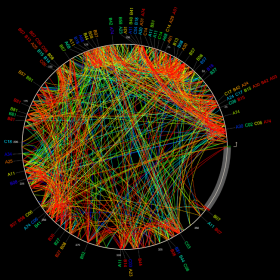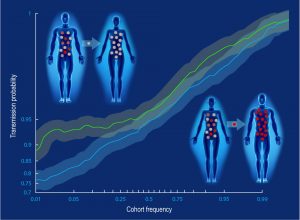Selection Bias at the Heterosexual HIV-1 Transmission Bottleneck
- Jonathan M. Carlson ,
- Malinda Schaefer ,
- Daniela C. Monaco ,
- Rebecca Batorsky ,
- Daniel T. Claiborne ,
- Jessica Prince ,
- Martin J. Deymier ,
- Zachary S. Ende ,
- Nichole R. Klatt ,
- Charles E. DeZiel ,
- Tien-Ho Lin ,
- Jian Peng ,
- Aaron M. Seese ,
- Roger Shapiro ,
- John Frater ,
- Thumbi Ndung'u ,
- Jianming Tang ,
- Paul Goepfert ,
- Jill Gilmour ,
- Matt A. Price ,
- William Kilembe ,
- David Heckerman ,
- Philip J. R. Goulder ,
- Todd M. Allen ,
- Susan Allen ,
- Eric Hunter
Science | , Vol 345(6193)

A fitness bottleneck in HIV transmission
Selection bias at the heterosexual HIV-1 transmission bottleneck
Jonathan M. Carlson*#, Malinda Schaefer*, Daniela C. Monaco, Rebecca Batorsky, Daniel T. Claiborne, Jessica Prince, Martin J. Deymier, Zachary S. Ende, Nichole R. Klatt, Charles E. DeZiel, Tien-Ho Lin, Jian Peng, Aaron M. Seese, Roger Shapiro, John Frater, Thumbi Ndung’u, Jianming Tang, Paul Goepfert, Jill Gilmour, Matt A. Price, William Kilembe, David Heckerman, Philip J. R. Goulder, Todd M. Allen, Susan Allen and Eric Hunter#
Science, 345(6193):1254031, July 2014.
Free access options for those without institutional access:
Abstract
Reprint (pdf)
Full text
Unrestricted author version (pdf)
Website and source code are available here.
A full presentation of this work can be viewed here.
Abstract
Heterosexual transmission of HIV-1 typically results in one genetic variant establishing systemic infection. We compared, for 137 linked transmission pairs, the amino acid sequences encoded by non-envelope genes of viruses in both partners and demonstrate a selection bias for transmission of residues that are predicted to confer increased in vivo fitness on viruses in the newly infected, immunologically naïve recipient. Although tempered by transmission risk factors, such as donor viral load, genital inflammation, and recipient gender, this selection bias provides an overall transmission advantage for viral quasispecies that are dominated by viruses with high in vivo fitness. Thus, preventative or therapeutic approaches that even marginally reduce viral fitness may lower the overall transmission rates and offer long-term benefits even upon successful transmission.
Overview
HIV is characterized by a tremendous rate of mutation, that leads to a high level of genetic diversity within and among patients. Yet transmission is frequently (~90%) established by a single genetic varient. What (if anything) is so special about that “founder” virus? In close collaboration with Eric Hunter’s group at Emory, we showed in Science today, which featured an excellent focus on HIV, that founder viruses are characterized by a higher level of predicted fitness. Strikingly, this fitness bottleneck is stronger in men than in women, consistent with other data showing women are more easily infected than men–unless the man had genital inflammation. As noted by Sarah Joseph and Ron Swanstrom in their perspective piece, this means that exposure frequently results in the non-productive infection of target cells, providing a window in which stronger viruses can outcompete weaker viruses, as well as a window in which vaccines or drugs may be able to raise the bar for any virus to be able to establish systemic infection. It brings up an interesting and important paradox: Individuals with higher biological risk are more likely to be infected; but when they are infected, it’s more likely to be by a weaker virus, leading to less severe disease. Among other things, this predicts that, as the standard of care moves toward preventative treatment of high risk individuals, a side effect of reduced transmission rates will be an increase in the severity of disease when breakthrough infection does occur, something we’ll have to keep a close eye on.
Update: Indeed, a recent publication shows that women infected despite using gels laced with drugs had higher viral loads than those in the placebo arm. Fortunately, there was no (significant) increase in CD4 decline, but the VL results are in line with our predictions, and raise the unsettling possibility that this effect will lead to higher downstream transmission rates for women infected while using PrEP. Again, will be important to follow further.
Resources
Check out the supplemental files for the raw data, or genbank for the sequence data. Note: we used escape associations for this publication, and thus published these in the supplemental excel file here. As of this writing, this is the best clade C HLA escape and compensation associations we have. Please feel free to use these as needed, using this paper as the citation.
Principal collaborators
This work was the result of a truly collaborative effort. The primary data came from Susan Allen’s Zambian discordant couple cohort, a visionary cohort established two decades ago that enrolls, counsels, and provides condoms to cohabitating, heterosexual couples in which one individual is HIV+ and one is HIV-. Eric’s group, in collaboration withmany folks from UAB, have been looking at the genetics and molecular virology of transmission for a number of years. To this great team, we at MSR brought a big data, statistical perspective. In this case, no new methods were needed: we just needed to cleverly apply the established approach of generalized linear mixed models to tease out effects that had been hiding in the data all this time.
Eric Hunter
Susan Allen
Malinda Schaefer
In the news
This story has been picked up by the blogsphere, with independent stories by NPR, Healthline, Emory, DW [German],Guokr [Chinese], and SINC (Spanish). If you don’t have access to Science, you can read the authors’ version (pdf), which is the accepted version of the paper prior to editorial copyediting and layout.
Also, I would encourage you to read Sarah Joseph’s and Ron Swanstrom’s perspective piece.
